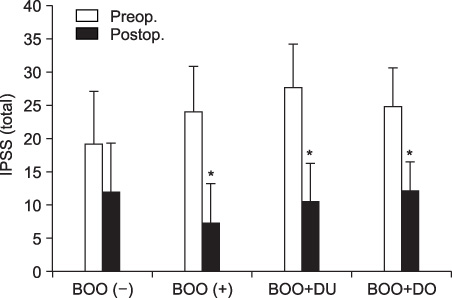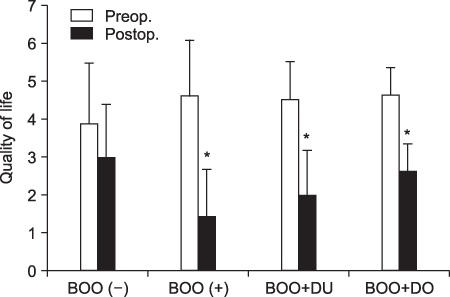Korean J Urol.
2007 Sep;48(9):965-970. 10.4111/kju.2007.48.9.965.
The Outcome and Satisfaction of Patients with Lower Urinary Tract Symptoms/Benign Prostatic Hyperplasia following Transurethral Resection of the Prostate according to Urodynamic Obstruction and the Bladder Function
- Affiliations
-
- 1Department of Urology, College of Medicine, The Catholic University of Korea, Seoul, Korea. kjc@catholic.ac.kr
- KMID: 2061299
- DOI: http://doi.org/10.4111/kju.2007.48.9.965
Abstract
- PURPOSE
We compared the clinical and urodynamic findings of patients suffering with lower urinary tract symptoms(LUTS)/benign prostatic hyperplasia(BPH) and who underwent transurethral resection of the prostate, and we tried to determine the effect of urodynamical obstruction and the bladder function on the result of this operation.
MATERIALS AND METHODS
101 patients with LUTS/BPH were categorized in four groups based on the findings of the preoperative urodynamic study: 15(14.8%) patients without bladder outlet obstruction[(BOO(-)], 50 (49.5%), patients with BOO[(BOO(+)], 12 patients(11.8%) with BOO and with detrusor underactivity(BOO+DU), and 24 patients(23.7%) with BOO and with detrusor overactivity(BOO+DO). The outcomes and satisfaction were analyzed by the changes of the International Prostate Symptom Score(IPSS) and the quality of life(QoL) index before and after transurethral resection of the prostate(TURP), respectively.
RESULTS
The Qmax was significantly high and residual urine was significantly low in group BOO(-). The PdetQmax was significantly high in group BOO(+) and also in the BOO+DO group. In group BOO(-), the decrease of the total IPSS was smaller than that noted in the other groups. There were significant decreases of the IPSS after TURP in groups BOO (+), BOO+DU and BOO+DO each voiding and storage subscore were decreased,but in group BOO+DO, the improvement was not as much as that in the other groups. The QoL was improved significantly in group BOO compared to the other groups.
CONCLUSIONS
Performing urodynamics preoperatively helps to predict the degree of symptom relief, and a higherbaseline BOO positively predicts the postoperative improvement of the IPSS and the QoL. The outcome of the BOO+DU group was satisfactory, but storage symptoms still existed for the BOO+DO group.
Keyword
MeSH Terms
Figure
Reference
-
1. Chaikin DC, Blaivas JG. Voiding dysfunction: definitions. Curr Opin Urol. 2001. 11:395–398.2. Grossfeld GD, Coakley FV. Benign prostatic hyperplasia: clinical overview and value of diagnostic imaging. Radiol Clin North Am. 2000. 38:31–47.3. Mebust WK, Holtgrewe HL, Cockett AT, Peters PC. Transurethral prostatectomy: immediate and postoperative complications. A cooperative study of 13 participating institutions evaluating 3,885 patients. J Urol. 1989. 141:243–247.4. Doll HA, Black NA, MaPherson K, Flood AB, Williams GB, Smith JC. Mortality, morbidity and complications following transurethral resection of the prostate for benign prostatic hyperplasia. J Urol. 1992. 147:1566–1573.5. Andersson KE. Storage and voiding symptoms: pathophysiologic aspects. Urology. 2003. 62(5):Suppl 2. 3–10.6. Abrams PH. Objective evaluation of bladder outlet obstruction. Br J Urol. 1995. 76:Suppl 1. 111–115.7. Lee JG, Shim KS, Koh SK. Incidence of detrusor underactivity in men with prostatism older than 50 years. Korean J Urol. 1999. 40:347–352.8. Abrams P. In support of pressure-flow studies for evaluating men with lower urinary tract symptoms. Urology. 1994. 44:153–155.9. Abrams PH, Farrar DJ, Turner-Warwick RT, Whiteside CG, Feneley RC. The results of prostatectomy: a symptomatic and urodynamic analysis of 152 patients. J Urol. 1979. 121:640–642.10. Jensen KM. Clinical evaluation of routine urodynamic investigations in prostatism. Neurourol Urodyn. 1989. 8:645–678.11. Rollema HJ, Van Mastrigt R. Improved indication and follow-up in transurethral resection of the prostate using the computer program CLIM: a prospective study. J Urol. 1992. 148:111–115.12. Shäfer W, Nopponey R, Rubben H, Lutzeyer W. The value of free flow rate and pressure flow studies in the routine investigation of BPH patients. Neurourol Urodyn. 1988. 7:219–221.13. Rosier PF, Rollema HJ, van de Beek C, Janknegt RA. Diagnosis of prostatism: relation between symptoms and urodynamic evaluation of obstruction and bladder function. Neurourol Urodyn. 1992. 11:399–400.14. Thomas AW, Cannon A, Bartlett E, Ellis-Jones J, Abrams P. The natural history of lower urinary tract dysfunction in men: the influence of detrusor underactivity on the outcome after transurethral resection of the prostate with a minimun 10-year urodynamic follow-up. BJU Int. 2004. 93:745–750.15. Gotoh M, Yoshikawa Y, Konodo AS, Konodo A, Ono Y, Oshima S. Prognostic value of pressure-flow study in surgical treatment of benign prostatic obstruction. World J Urol. 1999. 17:274–278.16. Hyman MJ, Groutz A, Blaivas JG. Detrusor instability in men: correlation of lower urinary tract symptoms with urodynamic findings. J Urol. 2001. 166:550–553.17. van Mastright R, Rollema HJ. The prognostic value of bladder contractility in the transurethral resection of the prostate. J Urol. 1992. 148:1856–1860.18. Thomas AW, Abrams P. Lower urinary tract symptoms, benign prostatic obstruction and the overactive bladder. BJU Int. 2000. 85:Suppl 3. 57–68.19. Gormley EA, Griffiths DJ, McCracken PN, Harrison GM, McPhee MS. Effect of transurethral resection of the prostate on detrusor instability and urge incontinence in elderly males. Neurourol Urodyn. 1993. 12:445–453.20. Seaman EK, Jacobs BZ, Blaivas JG, Kaplan SA. Persistence or recurrence of symptoms after transurethral resection of the prostate: a urodynamic assessment. J Urol. 1994. 152:935–937.21. Kakizaki H, Machino R, Koyanagi T. Clinical experience in lower urinary tract symptoms. BJU Int. 2001. 88:Suppl 2. 23–26.22. Im JG, Kim JC, Hwang TK. The urodynamic findings of male patients with LUTS and the effects of the pre-operative parameters on the outcome of transurethral resection of the prostate. Korean J Urol. 2005. 46:1256–1261.
- Full Text Links
- Actions
-
Cited
- CITED
-
- Close
- Share
- Similar articles
-
- Evaluation of Persistent Lower Urinary Tract Symptoms after Transurethral Resection of Prostate
- Review of Current Laser Therapies for the Treatment of Benign Prostatic Hyperplasia
- An Anteriorly Positioned Midline Prostatic Cyst Resulting in Lower Urinary Tract Symptoms
- Huge Benign Prostatic Hyperplasia
- Benign prostate hyperplasia




